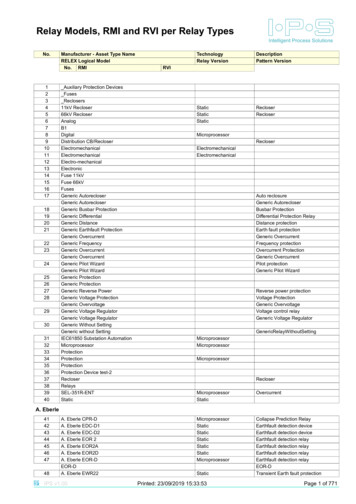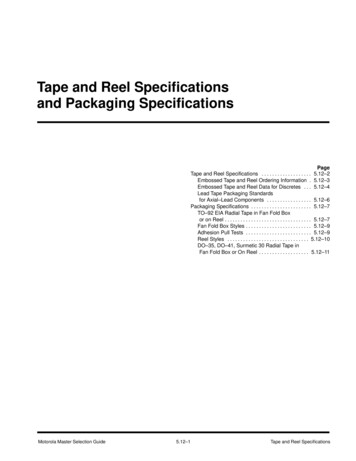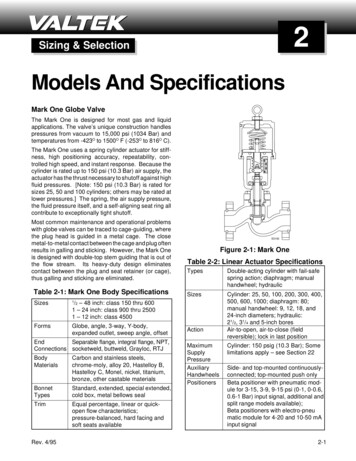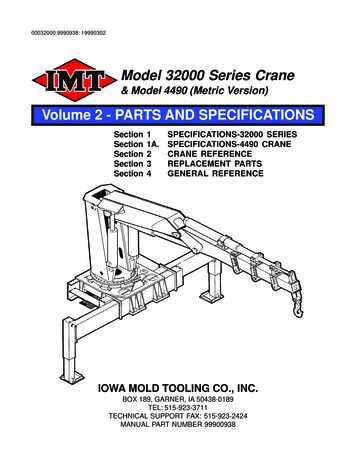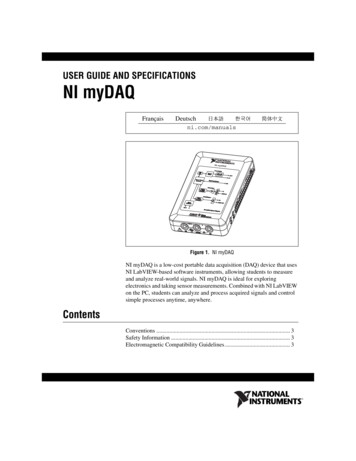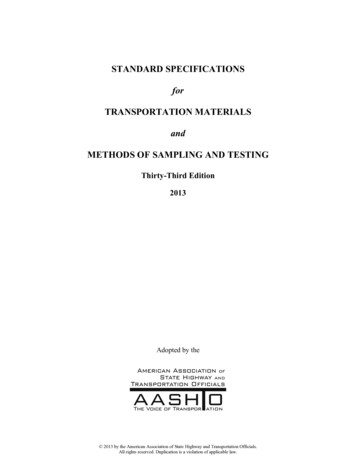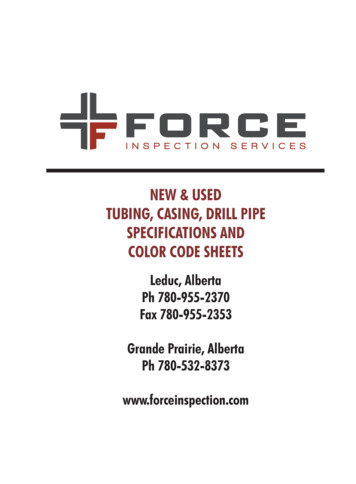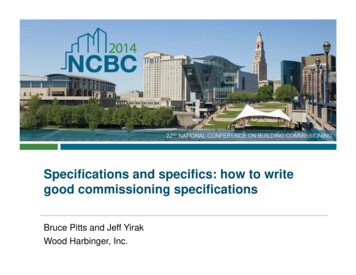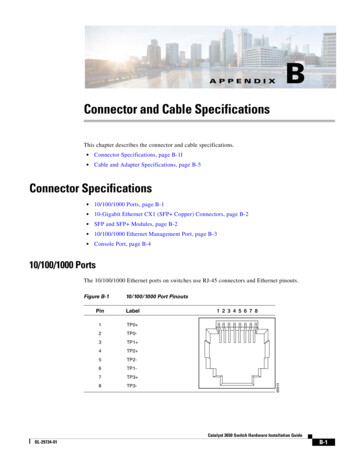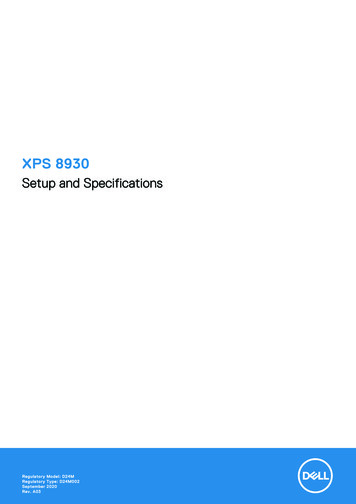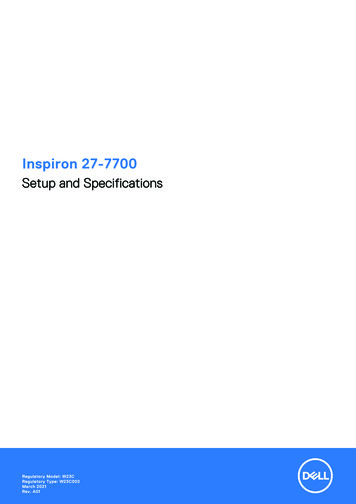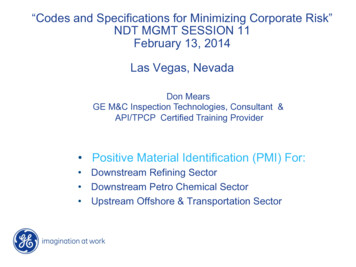
Transcription
Specifications and the RMIR-Mark Certification ProcessSponsored by:Presented by:Arlin Keck – Steel KingDan Clapp - FrazierSimon Brain – WirewayHusky2013 MHI Copyright claimed as to audiovisual works of seminar sessions and soundrecordings of seminar sessions. All rights reserved.
Rack Manufacturers Institute&Certification
About RMI Independent, incorporated non-profit Trade AssociationFormed in 1958Mission: To advance standards, quality and safety in the use of IndustrialSteel Storage Rack ProductsMembership requirements:– Must control the structural design and manufacture of storage products made for salein the USA– Pay dues to support RMI Mission– Actively participate in meetings– Participate in the monthly statistical program– Voluntarily agree to design rack in accordance with RMI/ANSI 16.1-2012 Members are leading manufacturers from the US and other countriesCurrent membership consists of 17 storage rack companies and 5associate members producing rack decking
What is RMI Certification? Voluntary process Standards based – ANSI-MH16.1- 2012 Independently validated by ProfessionalEngineers outside of the RMI License allowing application by thecompany’s Registered ProfessionalEngineer
What Does Certification do forthe Customer? Provides independent verification of acompany’s compliance with the IndustryStandard Ensures that a company knows how tocomply with the current code Differentiates companies that mayotherwise appear similar
How Does a Manufacturer ObtainCertification? Manufacturer conducts component testing Submits test data along with designcalculations and load tables to the RMI Demonstrates compliance with RMI code RMI administers the process and submitsdocuments to two independent P.E.’s RMI awards an R-Mark license followingapproval of both P.E.’s
Testing Stub ColumnCantilever TestCyclic Connection TestingDetails later in our presentation
Testing Machine for Stub Columns
How to Determine If Your Rackis Certified R-Mark on Published Load Tables R-Mark on Installation Drawings Visit www.mhi.org/rmi for the latest list ofcompanies with the R-Mark
Frame Capacity Table
Beam Capacity Table
Drawing Sealed with the R-Mark
Specifications, Codes andDesign Practices
Why Should I Ask forthe RMI/ANSI Specification? Best Design Practice Required by 2012International Building Code Uniform Testing Methods
Best Design Practices Proper accounting for possible columnstrength reduction due to holesInclusion of latest LRFD loadcombinationsLoading combinations including pallets(product loads) and proper load factorsSpecification of performance of shelfconnection locking device
Best Design Practices Shelf beam deflection limitsDesign requirements for cross-aisle tyingand anchoringDefinition of column design parametersand frame bracing location tolerancesStorage rack seismic design
Best Design Practices Detailing of owner’s responsibilitiesImplementation of the recommendations fromFEMA 460Seismic design factors from ASCE 7-10 andused in IBC 2012Connection rotational capacity requirements andtesting proceduresInclusion of pick-module designDetails of base plate & shimming
Acceptance by Building Code Storage rack referenced standard in theInternational Building Code (IBC) cation.php
Acceptance by Building Code Uses Seismic DesignCategories– IncludesSeismic Use GroupGround MotionSite Factor– Replaces old“Seismic Zones”
Acceptance by Building Code American Society of Civil EngineersASCE-7 10
Acceptance by Building Code International Building Code (IBC) 2012One or more InternationalCodes currently enforcedstate-wideSource:One or more InternationalCodes currently enforcedwithin state at local mlAdopted state-wide withFuture enforcement date
Acceptance by Building Code IBC is the building code adopted in all 50statesDifferent states use different IBC editionsThe 2012 RMI Specification is expected to beincluded by reference, without exceptions, bythe ICC for the 2015 International BuildingCode2012 IBC is the latest edition being adopted bythe states
Acceptance by Building Code The ICC has issued an updated IBC everythree years since 2000Each jurisdiction adopts an edition of the IBCand updates their adoption periodicallyThe 2012 IBC references the RMI 2008 edition2012 IBC is the latest edition being adopted bythe states
Acceptance by Building Code Seismic Design:1. Proper use of storage rack periodapproximations2. Seismic load distribution when first shelf is12” or less above floor3. Suggested period determination based onconnection stiffness testing
Acceptance by Building Code System IdentificationPlaqueLoad generalitiesLoad Application andRack ConfigurationDrawingsConfiguration Specifics
Uniform Testing Methods Beam-to-column connection test includingseismic cyclical test procedure Stub column test Optional tests– Shelf capacity– Upright frame tests
Uniform Testing Methods Beam-to-column connection test includingseismic cyclical test procedure
Uniform Testing Methods Stub column test
How To Be Sure You ReceiveAn RMI Certified ProductSpecify that all racking components conformto the RMI/ANSI MH16.1-2012 Standardand further require the R-Mark on theCapacity Plaque and the Load Applicationand Rack Configuration Drawings
Introducing R-MarkforWelded Wire Deck
The Wire Deck Industry Group hasjoined theWhy?
Wire Deck & The RMI Generally– Wire Deck was previously part of the IMCWD (IndustrialMetal Container & Wire Deck) Group of MHI but choseto join the RMI because Wire Deck is almostexclusively an accessory of Pallet Rack Specifically– To promote consumer education on the safeapplication of Wire Deck– To promote application of the existing Wire DeckStandards
Existing StandardANSI MH26.2 Standard
ANSI MH26.2 StandardTesting Principles Wire Deck capacities are based on loadingfrom a ‘Uniformly Distributed Load’ Wire Deck testing includes:– A safety factor of 1.67– Does not account for impact loading or for‘point loads’– Safety factor mirrors rack beams
ANSI MH26.2 StandardTesting ProcedureANSI: MH26.2Two Line Load TestDefined testing machinerequirements
ANSI MH26.2 StandardTesting ProcedureThe ‘two-line’ load testmethod, with the loadlines placed as shown atthe 1st and 3rd quarterpoints, mathematicallyequates to a ‘UniformlyDistributed Load’ of thesame magnitude
ANSI MH26.2 StandardTesting Procedure Protocol:– Load the Deck to allowable deflection (depth/165) andrecord applied load W1 Applied Allowable Load– Load the Deck until structural failure occurs and recordthe applied load W2 Applied Failure Load/2– Deck is rated as the lesser of the two values; W1 orW2– This is equivalent to a safety factor of 1.67 (mirroringrack beams)
ANSI MH26.2 StandardThe Standard Applied in Practice
In Practice Wire Deck capacities are based on UniformlyDistributed Loading. Approximately 90% of theload bearing capacity of the Deck is provided bythe supporting channels. Therefore, the ANSI Wire Deck capacity isapplicable to a load base that distributes the loadevenly over all of the supporting channels for, atminimum, that part of the Deck which issuspended unsupported between the inner edgesof the supporting rack structure.
In PracticeLoadDistance between inner edges of beamsShelf Load
In PracticeLoadDistance between inner edges of BeamsPallet Load
In PracticeNon ANSI application of Wire Deck!
The R-MarkSo what’s changing from ANSI MH26.2?
The R-Mark In terms of theoretical and practical applicationof Wire Decks nothing! However, the whole Engineering Standard willnow follow - and be subject to - the RMIindependent verification protocol– Wire deck members of former IMCWD groupare now Associate members of the RMI– The ANSI MH26.2 standard is now the WireDeck R-Mark standard
The R-Mark Most importantly ‘voluntary’ adherence to theIndustry Standard will not be adequate for anR-Mark . . .– Engineering must be approved byindependent Professional Engineers– Capacity load tables must be approved byindependent Professional Engineers– Material specifications & certifications mustbe approved by independent ProfessionalEngineers
BenefitsThe RMI has a market testedmechanism to level the playing fieldusing approved Engineering Standards
Benefits The R-Mark allows for consumer confidence whenpurchasing welded wire rack decking The independent PE protocol of the R-Markengenders confidence in the validity of eachmanufacturer’s certification Comparing R-Mark products allows for anobjective evaluation of compliant products fromcertified suppliers
Consumer ValidationAs a consumer, how can I be sureI receive R-Mark product?
ValidationSame as Rack,look for theR-Mark! the ‘Blue’one in this case
ValidationOn Load TablesFamily:Step Beam ApplicationsMesh Pattern: 2.5"x4"Mesh Gauge: 6.0 (0.191" - 0.193")Deck Depth 3-chnls(Inches)3Channel Gauge: 13 (0.083"- 0.089")4-chnls 5-chnls 6-chnls 7-chnls 889841,3111,6391,9672,2952,623ASTM A510 / Yield Min 30ksi
ValidationSealed on Drawings
Specifications RMI/ANSI MH 16.1-2012 RMI/ANSI MH 26.2-2007www.mhi.org/rmi
For MoreInformation:Jeff WoronieckiMHI Managing Executivejworoniecki@mhi.orgwww.mhi.org/rmi
MembersAdvance Storage ProductsBulldog Rack CompanyDACS, Inc.Elite Storage Solutions, Inc.Engineered ProductsEquipement Boni Inc.Frazier IndustrialHannibal Industries, Inc.Interlake Mecalux Inc.ITC ManufacturingJ&L Wire Cloth LLCKonstantNashville Wire Products, Inc.Nedcon USA, Inc,Ridg-U-Rak, Inc.SpaceRak, Division of Heartland Steel Products, Inc.Speedrack Products Group, Ltd.Steel King Industries, Inc.Twinlode CorporationUnarco Material Handling, Inc.Wireway Husky Corporation
Q&A
Standards based – ANSI-MH16.1- 2012 Independently validated by Professional Engineers outside of the RMI License allowing application by the company’s Registered Professional Engineer
